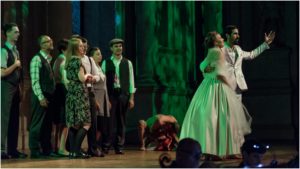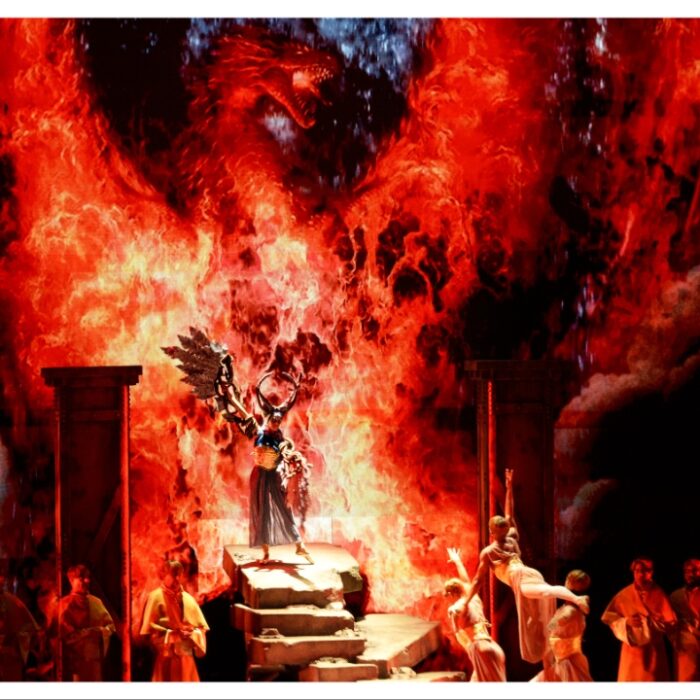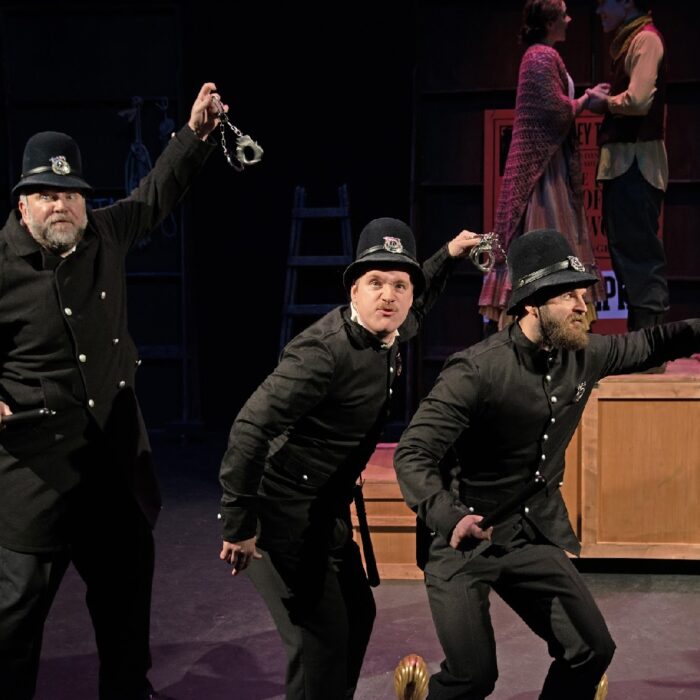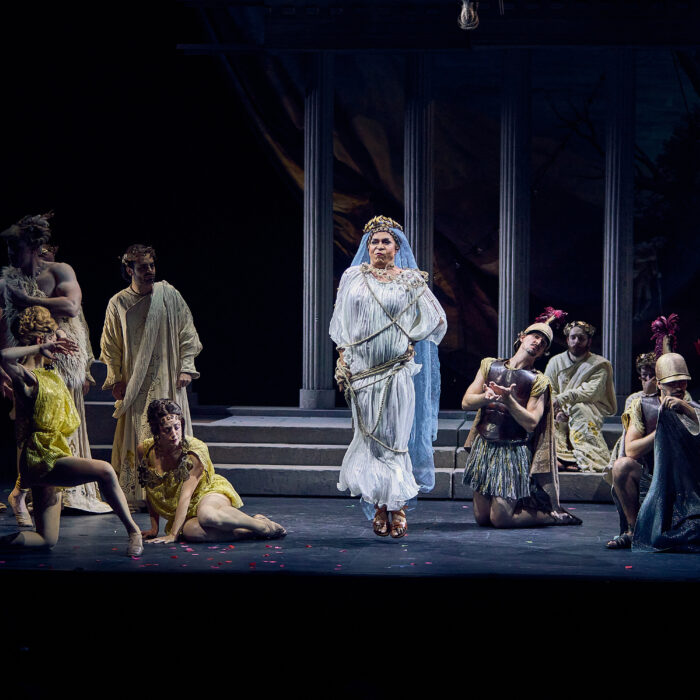
Teatro Olimpico Review 2017 – L’Orfeo: Strong Singing & Gorgeous Theater Deliver Memorable Evening
By Alan NeilsonNo apologies are made for starting this review of Monteverdi’s “L’Orfeo” with a description of the venue, Vicenza’s Teatro Olimpico, which must count as one of the world’s most beautiful and architectural significant theatres. Designed by Palladio in 1580, it was described by Goethe as “a theatre based on the ancient model, but in small proportions and indescribably beautiful…”.
Palladio was commissioned to design a theatre for the Accademia Olimpica, of which he himself was a member. His design was based on the theatres of Ancient Rome, using descriptions by the Roman writer and architect Vitruvius. The theatre is small with an elliptical shape. It has a steeply raked seating area which allows for excellent view of the stage from all parts of the auditorium. There are no seats as such, but wooden cushioned rows. The auditorium is framed by a colonnade with a frieze, upon which are set statues in the classical style, which look down upon the audience and the performing actors. The ceiling is painted with a blue cloudy sky. The rectangular stage has a plaster/wooden set, which consists of an ornate façade, adorned with half columns, statues placed in niches and panels with bas-reliefs, with a large central arch and two smaller entrances on either side. Looking through the arch and entrances, it is possible to view streets and other buildings, representing the seven streets of Thebes. It was created for the theatre’s opening play, Oedipus by Sophocles, in 1585. The effect on seeing this theatre for the first time is truly stunning. Moreover, given the theatre’s unique late renaissance architectural environment, it is unlikely that a better venue could be imagined for a performance of “L’Orfeo,” which in fact was premiered in 1607, in the nearby city of Mantova, a mere 22 years after the theatre’s construction.
Dealing with Palladio
Yet, the fact that the theatre is so imposing and the fixed stage set so breathtaking, can, in themselves, create problems for a production. As Mauro Zocchetta, the scenographer, pointed out in the programme notes, “Every time a staged work is performed at the Teatro Olimpico it is the work of Andrea Palladio.” So what should a production team do? Fully embrace the scenery and take the chance that the production will be subsumed into Palladio’s design or ignore it completely and accept the possibility that the new set will sit awkwardly alongside Palladio’s designs? For this production of “L’Orfeo” the director, Andrea Castello, aided by Zocchetta, decided to take a middle path by incorporating Palladio’s set, but transforming it through the use of video mapping, that is by the projection of images and coloring onto the scenery to give it a different appearance. For example, the fields of Thrace are represented through the projection of silhouetted trees onto a green background, which changes to darker colors, then to black as Orfeo enters the Underworld. The statues in the niches and the columns were often highlighted in different colors, which contrasted well with the background colors. No extra scenery was used, all of which reminded one of Wieland Wagner’s post-war Bayreuth minimalist sets in which lighting was used to uncover the psychological motivations at the heart of Wagner’s works. In fact, the use of color played an important part in the whole of the production, including the costumes. The costume designer, Roberta Sattin, used color to define the characters: Orfeo dressed in white to symbolize a person outside time, containing the strength and fragility that exists within us all; Proserpina in purple to signify royalty; Apollo in yellow and so on.
Confusion
If Castello and his team had stopped at this point, this production of “L’Orfeo” would have been a clear, insightful and beautiful presentation, but unfortunately, they decided to incorporate too many further ideas, which had a confusing and distracting effect. A couple of examples will suffice to illustrate, but there were others: a male dancer weaved his dance, shadowing Orfeo’s inner emotional conflicts, who himself, was transformed over the course of the evening as he becomes aware of his sexual identity; the setting was shifted from Thrace to 1940s Vicenza, with projections of war planes flying overhead during the opening toccata, in later scenes there were images of bomb damage, and pictures of Vicenza throughout. Moreover, the costumes are given other symbolic meanings, beyond the colors. For example, in the 1940s women were required to perform a greater variety of tasks, thus the Messenger was dressed in a female suit, to symbolize her new role. Notwithstanding the fact that all the ideas had merit, taken as whole, it was all simply too much to absorb.
Infused with Youth
On the musical side, the singers were generally young, although already possessing varying degrees of singing and theatrical experience. They all engaged enthusiastically and confidently with the piece and no one produced a poor performance. As a group, they tended to emphasize the dramatic side of their singing, sometimes at the expense of ornamentation. They did, however, produce an engrossing and compelling musical fable.
La Musica, played by Giulia Bolcato, surprised the audience by appearing from the top of the seating area and singing the stanzas of the prologue, “Dal mio Permesso amato…,” while wandering down through the aisles, and providing the audience an unusually close-up experience in the process. She has already amassed a considerable amount of experience in notable theatres, such as Venice’s La Fenice, which clearly showed as she sang with a great degree of confidence and élan. She possesses a light soprano with a bell-like quality, which she used skillfully and to good effect. Her phrasing is subtle and nuanced, to which she added delightful embellishments. Bolcato also sang the roles of Euridice and the small part of Eco, both to the same high standard.
As Orfeo was the 27-year-old Marco Saccardin, who has already sung alongside singers such as Cecilia Bartoli, and in various high profile opera houses. He possesses a fine strong tenor, which easily filled the Teatro Olimpico, although he appeared unwilling (or unable) to modify its level, and thus lacked a little finesse. Certainly, bigger theatres than the Olimpico will not prove to be an obstacle for him. Nevertheless, he brought real poignancy to Orfeo’s suffering, and displayed skill in characterization. However, his ornamentation of the vocal line was not to the same standard. This was most clearly displayed in the delivery of Orfeo’s aria, “Possente spirto,” which, although sung with a great deal of passion, lacked the embellishment and decoration needed to raise it beyond the commonplace.
Valeria Giradello as the Messenger entered from the left-hand side of the stage, pulling a long silken black cloth behind her, which was also wrapped around her body. She walked, slowly, slowly across the stage, every step, every note dripping with sadness, her voice living the part. Giradella sang and acted the part to the full. She has a flexible soprano which she used marvelously to darken her voice to deliver the news of Euridice’s death.
The sopranos, Anna Bessi and Arianna Lanci, shared the roles of Hope and Proserpina, and both brought with them the experience of the early operatic repertoire. In the performance on September 6, Lanci played Proserpina and Bessi played the role of Hope. Lanci essayed the role with a regal air, looking and acting the part and made a convincing queen. She has a strong and nuanced soprano, with clear diction and a solid technique. Bessi made an equally effective portrayal in the small role of Hope. She delivered her lines with a great amount of sensitivity and subtlety. They reversed roles for the second performance.
The young Polish bass Mateusz Drozda played the role of Charon, situated half-submerged below the stage, enveloped in a black cloth. He possesses a strong, rounded and robust bass, however, he did not take full advantage of the part. When he first confronts Orfeo with “O tu ch’innanzi mort’ a queste rive,” his singing was rather dull and lacked character, yet following Orfeo’s response to which Charon replies “Ben mi lusinga a alquanto,” Drozda came to life. The strong rounded tone was still present, but this time used to greater purpose as he brought a more nuanced coloring to the vocal line and produced a much-improved portrayal. On the other hand, Fulvio Fonzi, a late arrival to the singing profession, possesses a deep, powerful resonant bass, which he used with a great deal of flexibility. He varied coloring and dynamic shadings in the creation of an imperious sounding Pluto. He also played the part of the 4th shepherd.
Uniquely among the cast was Enrico Busia as Apollo, who focused more on ornamentation than characterization, putting in an earnest performance, but sounding a little too mechanical. He also played the part of the first shepherd. Martina Loi made an excellent impression in the small role of the Nymph. Enrico Torre and Antonio Orsini also made good impressions as the second and third shepherds.
Star of the Show
Probably the star of evening, however, was the chorus. Its members were dressed as farmers or village folk in the Thracian scenes and as shades in the Underworld scenes. They acted skilfully and convincingly, their movements well-choreographed. They had been exceptionally well-drilled and sang with great skill and surety. The balance between the voice types was near to perfect. Through delightful phrasing and subtle dynamic contrasts, they brought out the nuances and beauty of their parts. On realizing that Euridice has been killed they cry out “Ahi caso acerbo…,” the effect was as stunning as it was chilling and helped create the most emotionally charged scene of the evening.
The Orchestra Schola S. Rocco along with Harmonia Parnassia was conducted by Francesco Erle. He produced some very good playing from individual soloists, especially during “Possente spirto,” and maintained a gentle balance between the stage and the pit. Although certain orchestral passages were beautifully delivered, notably the sinfonia at the beginning of second act and the moresca that concludes the opera, the overall performance lacked refinement and the necessary delicacy to highlight the real beauty to be found in Monteverdi’s music. Moreover, members of the Harmonia Parnassia, (trombones and cornets), were not successfully integrated, and occasionally sounded disconnected from the rest of the orchestra and their dynamics were not under tight enough control.
Overall, this was not a perfect performance of “L’Orfeo” and it certainly had a number of areas in which improvements could be made, yet it had a vitality and a drive that engaged, along with some very good individual performances. At the end it received an excellent reception from the audience, and it was not undeserved!


